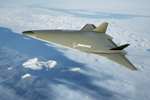Lockheed Martin rolls out X-59 supersonic X-Plane
The composites-intensive aircraft demonstrator was highlighted at a rollout ceremony at Lockheed Martin Skunk Works, and will soon undergo extensive testing prior to first flight later this year.
X-59 rollout in Palmdale, California. Photo Credit: Lockheed Martin Skunk Works
On Jan. 12, (Palmdale, Calif., U.S.) rolled out the X-59, a composites-intensive experimental aircraft designed for quiet supersonic flight. The company has been working on its design, manufacture, assembly and testing for more than 9 years under NASA’s (Washington, D.C., U.S.) Low-Boom Flight Demonstration project. (Learn more about its design here).
According to John Clark, vice president and general manager of Lockheed Martin Skunk Works, “This project is just one example of the broader ingenuity of our industry as we continually strive to push the envelope of what’s possible.” The X-59’s features have been specifically designed to “reshape” shock waves that occur during flight of the aircraft, resulting in a quiet sonic “thump.”
During its rollout ceremony, Lockheed Martin, NASA and government leaders celebrated its technical advancements, collaboration and innovation that stemmed from years of research, development and production of the “one-of-a-kind” technology demonstrator aircraft.
“The entire X-59 team leaned into the expertise of both legendary organizations, NASA and Lockheed Martin, to ensure success for this program,” adds Greg Ulmer, executive vice president of Lockheed Martin Aeronautics.
Next, the aircraft will complete ground tests including engine-run and taxi tests before its next major milestone, first flight, later this year. After the aircraft is validated in initial flight tests, it will move into the acoustic testing phase. This phase will include flights over populated areas to provide U.S. and international regulators with statistically valid data required to help approve new rules that could allow quiet commercial supersonic flight over land. This would cut commercial flight times to half of what they are today.
For additional information on the X-59, visit Lockheed Martin’s .
Related Content
-
Welding is not bonding
Discussion of the issues in our understanding of thermoplastic composite welded structures and certification of the latest materials and welding technologies for future airframes.
-
Infinite Composites: Type V tanks for space, hydrogen, automotive and more
After a decade of proving its linerless, weight-saving composite tanks with NASA and more than 30 aerospace companies, this CryoSphere pioneer is scaling for growth in commercial space and sustainable transportation on Earth.
-
“Structured air” TPS safeguards composite structures
Powered by an 85% air/15% pure polyimide aerogel, Blueshift’s novel material system protects structures during transient thermal events from -200°C to beyond 2400°C for rockets, battery boxes and more.






